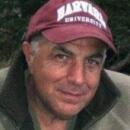Column: Thoughts from Dr. Joe: A ‘La Vita Nuova’ moment in a glorious setting
It was a bare-bones cabin, powered by a generator that was more trouble than it was worth. I burned oak in the old Franklin stove, circa 1932. Since oak is a slow burner, I turned the coals and a warm morning fire popped. Under the glow of a lantern, I made a delicious breakfast and prepared to finish the last 40 pages of my novel.
It was barely 6 a.m., and although the cabin was tucked in a grove of dogwood, oak, maple and aspen, I didn’t see the palette of fall colors waiting outside my door because it was still too dark. The cabin, which belongs to a buddy of mine, lies west of Chinese Camp, the remnant of a California Gold Rush town. In the 1850s, Chinese Camp was home to more than 5,000 Chinese laborers who worked the gold fields of the Southern Sierra. The sign that hung on State Route 120 outside of town noted: “Population 126.”
The morning light showed large yellow leaves falling softly to fulfill their destiny with the earth. I set a page break and began Chapter 54 of my novel. I intended to imitate the antics of Thoreau and sequester myself until I had finished. I had good intentions, but the words of Robert Burns once again proved to be true: “The best-laid plans of mice and men often go awry.”
I grabbed my coat and started driving through the glorious October color, headed to Hetch Hetchy Valley in the northwest corner of Yosemite National Park. The aspen, alder, big leaf maples and deer brush were vividly yellow, the sugar maples and dogwood were red and the poison oak had turned purple. This display was a spectacular backdrop to the stately green pine, hemlock oak and cedar trees. The air was clean and crisp, full of promise. I knew that something special was going to happen.
In 1923, the park service built the O’Shaughnessy dam that blocked the natural flow of the Tuolumne River, subsequently flooding Hetch Hetchy Valley. Their intent was to bring water to the burgeoning population of San Francisco. I have read many accounts that Hetch Hetchy Valley was as beautiful as the iconic Yosemite Valley.
During the fall of 1962 I accompanied my English teacher, Brother Jean Martel Baptiste, to his family’s farm in the Berkshire Mountains of Western Massachusetts. It was a life-changing experience, which I wrote of in my memoir “Eleven Stories from the Block.” Since that New England autumn with Brother Jean, I have luxuriated in the fall colors.
I headed to the valley to walk the Merced River under the shadow of Half Dome. “To everything, there is a season and a time to every purpose under the heaven” (Ecclesiastes). Spring is birth, summer exuberance, fall decline and winter, death. The thoughts of author Joe Wheeler came to mind: “Time remorselessly rambles down the corridors and streets of our lives, but it is not until autumn that most of us become aware that our tickets are stamped with a terminal destination.”
I had cleared a tree line and stepped into a small sunlit meadow where golden leaves fell abundantly. “Excuse me, sir,” a voice called out. I turned, and a young couple, Filipp and Alina, beckoned, asking that I take their picture. “We just got engaged,” Alina said with exuberance. She showed me her ring.
Standing amid the meadow, the falling leaves around them and with Half Dome in the background, they held each other. A mere photograph could never capture the love that radiated from them. But I readily saw it. There was an aura that encircled them. I lack the poetry of imagination to explain their joy. Alina’s eyes were the very definition of love, hope and promise. It was their gift to the earth.
I had experienced a reincarnation of Dante’s “La Vita Nuova” and finished my journey richer than when I began. I knew something special would happen on that beautiful autumn day.
Joe Puglia is a practicing counselor, a retired professor of education and a former officer in the Marines. Reach him at doctorjoe@ymail.com. Visit his website at doctorjoe.us.
